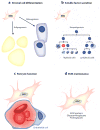Mesenchymal stem cells as therapeutics
- PMID: 20415588
- PMCID: PMC3759519
- DOI: 10.1146/annurev-bioeng-070909-105309
Mesenchymal stem cells as therapeutics
Abstract
Mesenchymal stem cells (MSCs) are multipotent cells that are being clinically explored as a new therapeutic for treating a variety of immune-mediated diseases. First heralded as a regenerative therapy for skeletal tissue repair, MSCs have recently been shown to modulate endogenous tissue and immune cells. Preclinical studies of the mechanism of action suggest that the therapeutic effects afforded by MSC transplantation are short-lived and related to dynamic, paracrine interactions between MSCs and host cells. Therefore, representations of MSCs as drug-loaded particles may allow for pharmacokinetic models to predict the therapeutic activity of MSC transplants as a function of drug delivery mode. By integrating principles of MSC biology, therapy, and engineering, the field is armed to usher in the next generation of stem cell therapeutics.
Figures





References
-
- Sekiya I, Larson BL, Smith JR, Pochampally R, Cui JG, Prockop DJ. Expansion of human adult stem cells from bone marrow stroma: conditions that maximize the yields of early progenitors and evaluate their quality. Stem Cells. 2002;20:530–41. - PubMed
-
- Lee MW, Yang MS, Park JS, Kim HC, Kim YJ, Choi J. Isolation of mesenchymal stem cells from cryopreserved human umbilical cord blood. Int J Hematol. 2005;81:126–30. - PubMed
-
- Kotobuki N, Hirose M, Takakura Y, Ohgushi H. Cultured autologous human cells for hard tissue regeneration: preparation and characterization of mesenchymal stem cells from bone marrow. Artif Organs. 2004;28:33–39. - PubMed
-
- Fouillard L, Chapel A, Bories D, Bouchet S, Costa JM, et al. Infusion of allogeneic-related HLA mismatched mesenchymal stem cells for the treatment of incomplete engraftment following autologous hematopoietic stem cell transplantation. Leukemia. 2007;21:568–70. - PubMed
Publication types
MeSH terms
Grants and funding
LinkOut - more resources
Full Text Sources
Other Literature Sources
Medical

